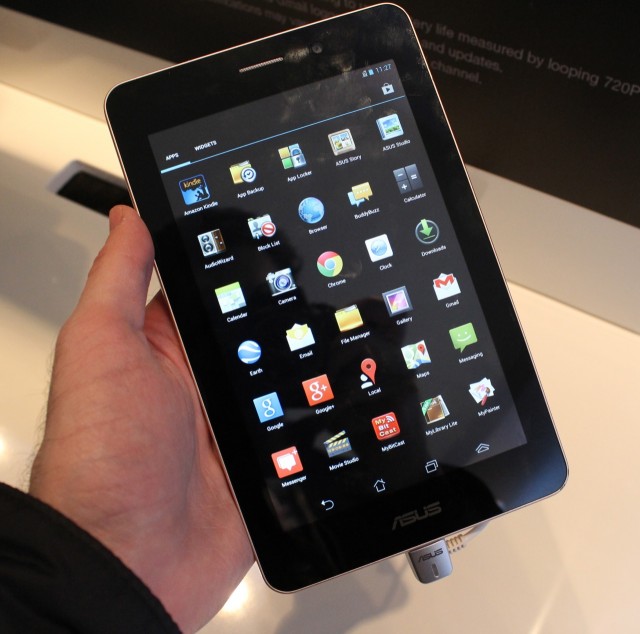
Handset makers these days seem intent on blurring the line between phones and tablets, and while there are plenty of large-screened phones on the floor here at Mobile World Congress, no one is going to the lengths that is Asus. At the company's press conference yesterday, it revealed two devices of interest: the FonePad, a 7" Android tablet that features 3G data and voice capabilities; and the PadFone Infinity, the latest iteration of their phone-and-tablet-dock concept that has been kicking around for awhile now.
We stopped by Asus' booth to log some hands-on time with both devices. Neither has been announced for the United States just yet, but they're likely to be a sign of things to come.
The FonePad, a tablet that's also a phone

Let's start with the FonePad. On its surface, it's very much a 7" Android tablet in the style of the Nexus 7 (a comparison made all the more apt by the fact that both are made by the same company). It has a 1280×800 display and runs a lightly skinned version of Android 4.1.2—not the stock Android 4.2 experience you get on the Nexus 7, but not terribly different. Like the Nexus 7, it includes 16GB of storage and 1GB of RAM. The European model (pictured) is also missing a rear camera, something that may give you pause if you're looking at it as a potential phone replacement (the Asian version will sport a 3MP rear camera, though).
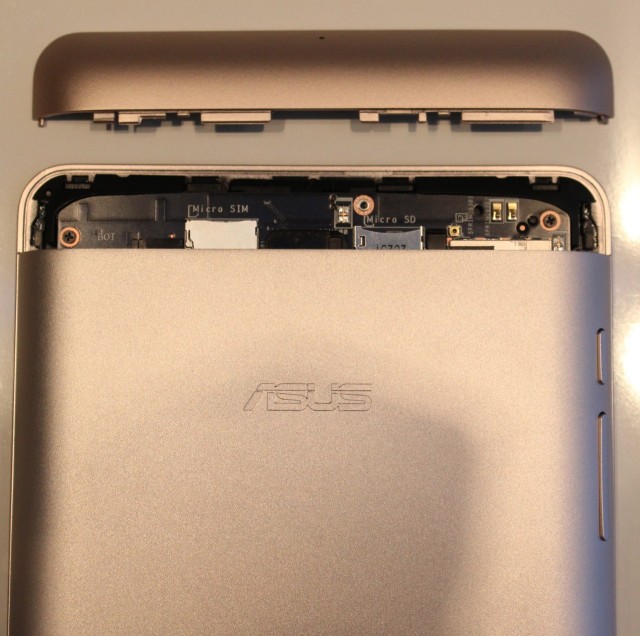

There are three differences of note. First, of course, is the device's signature voice calling capability—the top of the back case slides off to reveal a micro SIM slot (as well as a microSD slot, another difference from the Nexus 7), and once you've inserted one you can use it for data and for voice calls.
We couldn't test call quality, of course, since Asus' demo units didn't include SIMs, but we will say that it feels a little silly to hold something as large as the Fonepad up to your ear. It will no doubt be a workable solution for those who value a larger screen over all else in a phone—the ever-increasing size of smartphones seems to indicate that this demographic exists—or if you use a headset for most of your calls, but as a primary phone it strikes me as just a bit too large for comfort.

The second interesting thing about the Fonepad is that it's got Intel inside—though not, apparently, the same Clover Trail+ Atom processor we reported on yesterday. Rather, it uses the Atom Z2420 that Intel unveiled at CES last month, and while Jelly Bean seemed to run well enough on it it's certainly not Intel's fastest Atom. The Z2420 pairs a single-core 1.2GHz Hyperthreading-enabled Atom with a PowerVR SGX 540 GPU, the latter of which is even a bit slower than the GPU used in the Nexus 7's Tegra 3. It's also almost certain to be using and Intel modem—whether the older XMM 6260 or the newer 6360 isn't clear—but either way this means it won't support LTE.
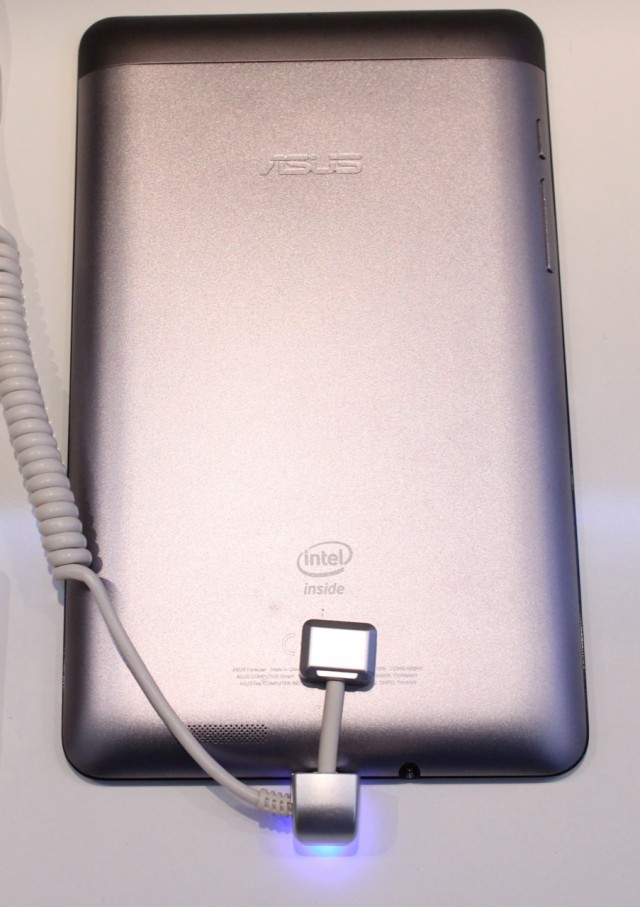
And, finally, we get to the build quality—the Nexus 7 is made mostly of plastic, and while for a $200 tablet it doesn't feel terribly cheap, it's also not the sturdiest thing in the world (the back of my own Nexus 7 has been known to come loose from the front if it falls off the bed, and while it snaps back together easily it doesn't inspire a ton of confidence). The Fonepad, by contrast, has a slightly rounded, smooth metal back that feels nice to hold. Whether it stays together better than my Nexus 7 is hard to divine from using the tablet for 15 minutes, but it does feel a little better.
There's no word on US availability for the FonePad, but it should be available in Asia for $249 in March and in Europe for €219 in April.
The PadFone Infinity, a phone that turns into a tablet
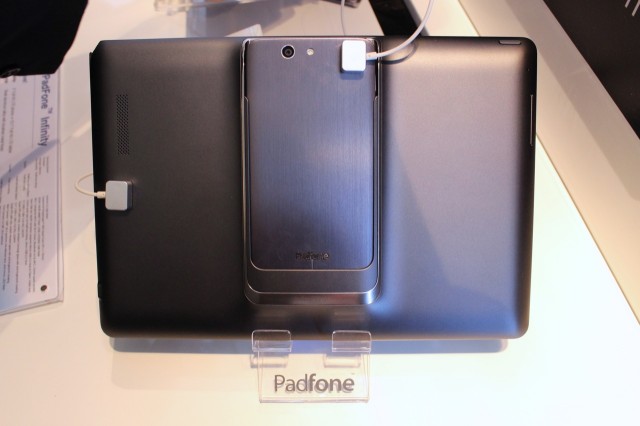
Asus' PadFone product line isn't new, but the PadFone Infinity updates the hardware to bring it in line with the rest of the high-end Android competition.
It starts with the phone, which even by itself is a relatively impressive handset. Like other high-end Android phones of late, it includes a 5" 1080p IPS display, a 1.7GHz quad-core Qualcomm Snapdragon 600 SoC, and 2GB of RAM. It's also got either 32 or 64GB of storage, a 13MP rear camera, a 2MP front camera, NFC, Bluetooth 4.0, dual-band Wi-Fi, and LTE support, all packed into a five ounce, 0.35" thick package.

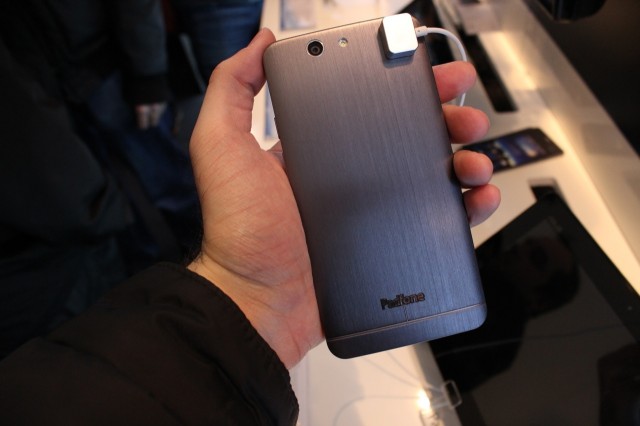

The phone has a lightly curved, brushed metal back and feels pretty good to hold. We weren't able to run our standard suite of benchmarks on the phone (or perform any battery life tests, given how power-hungry some of these quad-core 1080p phones are), but Asus' skinned Android install ran smoothly and without issues (Asus' presentation and spec sheet lists Android 4.2, though the devices themselves appear to be running Android 4.1.2—we'll give Asus the benefit of the doubt and assume the update will be available by the time the device launches). By itself it would be a fairly impressive high-end Android phone along the lines of other high-end Android phones we've been seeing lately.
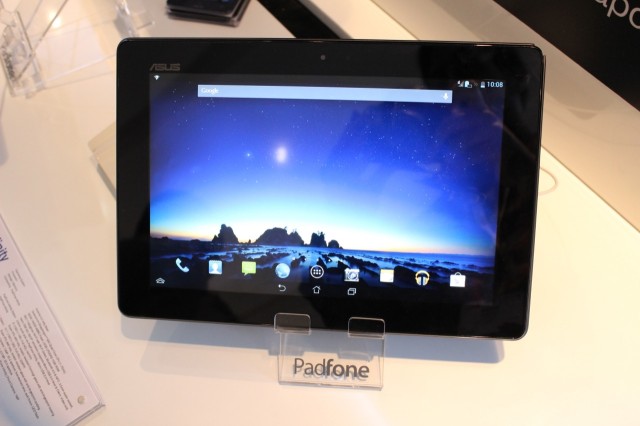
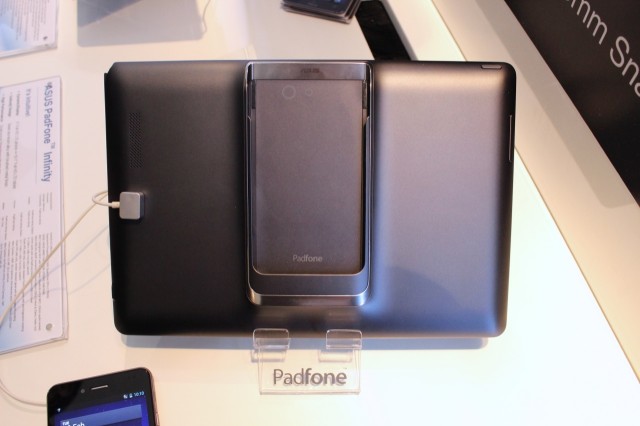
Where the PadFone Infinity differs, of course, is in its tablet shell. I call it a shell because there's really not a lot in it—a 10.1" 1920x1200 display, a battery that can recharge and extend the phone's talk time, a front-facing 1MP camera, and some extra internal antennae. All of the heavy lifting is done by the phone—the tablet uses the same storage, internals, connectivity interfaces, and camera, and therein lies the appeal of the device. If you have issues keeping your phone and tablet in sync with one another, just fold them into the same device.
Depending on how you hold your tablet, the PadFone in tablet mode can be a bit uncomfortable—the back of the tablet is a nice, smooth metal, but there's a bulge in the center for the cradle where the phone is inserted that might get in your way if you hand reaches the center of your tablet to hold it. The phone does seem to fit pretty securely in the tablet-dock, though, and while there's no physical latch or anything that keeps the phone in place, we wouldn't be too worried about it falling out on accident.
There are two potential issues with the PadFone, which launches in Europe in April: the first, for many, will be its price tag of €999, or just over $1,300—roughly commensurate with what you'd pay for an unlocked iPhone and an iPad; that combination would include a whole lot of hardware that Asus simply doesn't have to pay for in the tablet part of the PadFone.
The second is the downside of having two devices in one—if you find one of the two to be in some way deficient, you've got to replace both to get something new. There are probably people for whom this model make sense, surely, but at least for my part I can say that I'd rather replace each on its own schedule.
As with the FonePad, we don't yet have information about US availability for the PadFone, but we'll keep our ears to the ground.
What's in a name?
We'd be remiss if we didn't say something about the names. While at first glance the FonePad name makes sense as a play on the existing PadFone brand, after some time spent writing and talking about them it's far too easy to get them confused—if you mention PadFone or FonePad to someone, it's a near-certainty that you'll have to clarify whether you're talking about the phone-tablet or the phone-and-tablet dock, since the person being spoken to is unlikely to know which you mean without additional context (and there's a chance that the speaker may be mixing them up anyway).
This will undoubtedly be a minor point for some, but the potential for confusion strikes us as high—staying with the existing PadFone name and tacking a "7" onto the end to refer to the screen size may have been a safer approach. In either case, Asus continues to put together interesting hardware—both of these products will undoubtedly serve niches rather than a mass market, but they should serve those niches well.
No comments:
Post a Comment